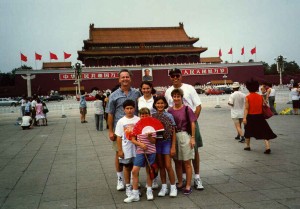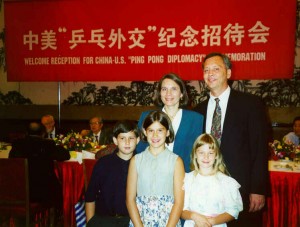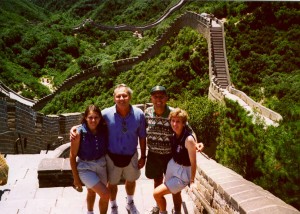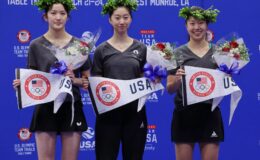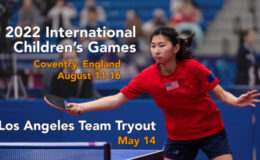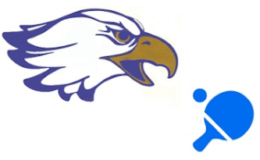Ping Pong Diplomacy
25th Anniversary Celebration — 1997
–By Judy Hoarfrost of Paddle Palace
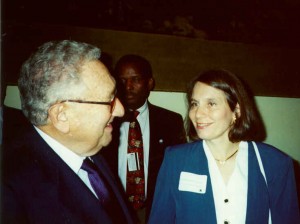
Henry Kissinger and Judy Hoarfrost
You could say that World Peace owes a lot to a little celluloid ball. A diverse group of American ping pong players were plunged Front Stage Center in the eyes of the world when they scored a visit to China, a country that had been isolated from the U.S. and the world for over two decades. The historic 1971 Ping Pong Diplomacy trip to China squeezed opened a crack in the heavy locked door to China, then Secretary of State Kissinger and President Nixon stuck their foot in the crack, and during the following 26 years the door has flown wide open.
This summer I had the awesome experience of participating in the 25th Anniversary Celebration of Ping Pong Diplomacy. In an exchange commemorating the player exchanges of 1971 (U.S. to China) and 1972 (China to U.S.), my family and I and our U.S. delegation had a fantastic visit to China, preceded by the visit of a delegation of Chinese players and officials to the United States. The official events began with a reception party at the United Nations in New York City, hosted by the National Committee on U.S.-China Relations, a sponsor of the 1972 trip of the Chinese team to the U.S. . Under a huge wall-hanging of the Great Wall, a gift from the Chinese government, the reception took place in the prestigious Delegates’ Lounge. Former Secretary of State Henry Kissinger was the keynote speaker. Also there were former President Nixon’s daughter Tricia Nixon and her husband and son, who said they wouldn’t have missed this event commemorating something so close to the former president’s heart. Members of the original 1971 U.S. delegation attending were Tim Boggan, George Braithwaite, Rufford Harrison, Judy Hoarfrost, Dick Miles, and Connie Sweeris. The Chinese delegation included former champions involved in the original Ping Pong Diplomacy such as Zhang Xielin (now Vice President of China Table Tennis Association), Liang Geliang (current World Senior Champ who has been living and coaching in Germany for 12 years), Lim Wai Hing (who now has an import/export business in Hong Kong), and Zheng Minzhi. Current champions accompanied the delegation, along with special guest Xu Yinsheng, President of ITTF and President of the Chinese Table Tennis Association. Xu Yinsheng is father of Vincent Xu who has resided in the U.S. for six years and is a top player. Vincent was instrumental in organizing both the U.S. and China portions of this 1997 Ping Pong Diplomacy Celebration.
Some “Friendship Matches”, singles and mixed doubles, were played between the former U.S. and Chinese champions, then we saw inspiring exhibiexhibitions between current Olympic and World Women’s Champ Deng Yaping and # 4 World-ranked Yang Ying, and between Olympic Men’s Champ Liu Guoliang and #8 World-ranked Ding Song. Media coverage in the U.S. of Ping Pong Diplomacy #2 was fairly good; CNN did a special presentation on the event, and a group of us did a spot on Good Morning America with interviewer Charles Gibson. Journalists from China Central TV accompanied the Chinese delegation and besides the continuing coverage that is aired in China, they are doing a documentary of the whole 25th Reunion Celebration to be televised in China in September. Among other publications, New York Times and Sports Illustrated had articles on the reunion. The Chinese delegation went on to the San Francisco area. They performed in a two-hour table tennis event at Maples Pavilion at Stanford University in front of 2500 screaming fans. Scott Preiss started things off, wearing a cordless microphone and mixing it up with the crowd. As always, he put on an entertaining exhibition including an amazing countersmash behind his back. There was a series of China world class player vs. “best in California” players, then a great exhibition match between Liu Guoliang and Ding Song. Next stop for the Chinese delegation was Los Angeles where they attended a reception at the Chinese Consulate. They finished off their 12-day tour of the U.S. with a stop in Hawaii. The most thrilling part of the Anniversary Celebrations for me was the second portion, the U.S. Delegations’ visit to China. This was my first trip back to China since 1971. The incredible changes that have taken place in China in the last 25 years I had heard about. But it is another thing to experience China firsthand. Of the fifteen original members of the 1971 Ping Pong Diplomacy delegation to China three of us made it back to China for this celebration: Connie Sweeris, Rufford Harrison, and myself, Judy Hoarfrost. My husband and three children accompanied me, and Dell Sweeris (who missed out on China the first time around while he coached a U.S. Junior team in England,) accompanied Connie. Dr. Jing T. Wang, current Executive Vice President of the USATT, originally from Taiwan and now a doctor in Los Angeles, also joined us.
Rising U.S. stars Barney Reed and Sean Lonergan were included as players in an eight-person international invitational tournament to be held in conjunction with the Ping Pong Diplomacy 25th Reunion. They had arrived in China two weeks earlier to get some first-class training and competition. After Spartan conditions at the training camp in a rural area outside Beijing, they were happy to join us at the first-class Beijing Olympic Hotel. Connie and I enjoyed mothering “the boys”; hemming Sean’s pants for the Great Hall of the People reception, and kidding back and forth with Barney, whose card tricks and jokes amused my kids. Barney and Sean were sweet to include my nine-year-old son Ryan as he tagged along with them at the competition, lounging in the players’ room with Saive, Persson, Matsushita, Kong Linghui, Liu Guoliang, and Kim Taek Soo.
We were all immediately thrust into the dizzying role of “Ping Pong Diplomats” starting with a press conference at the hotel. I was expecting maybe one camera and a reporter or two. I wasn’t prepared for the onslaught we received as we walked off the elevator onto the 2nd floor. Like Connie and the others, immediately I was engulfed in bright lights, cameras, and reporters jockeying to get the first interview. In the middle of my second or third interview, I turned around to see my 8-year-old daughter, Adrienne, dwarfed by oversized TV cameras and bright lights, calmly giving her own interviews, (“Yes, I like China.”, “I like Chinese food. I eat it in America”, “Yes, I am very proud of my mother”.) We were then ushered into a room where a long table had been set for tea for eight, with chairs for reporters facing us, and then began a more formal press conference, beginning with Rufford Harrison, official head of the 1997 U.S. Delegation, and continuing with myself, Jean-Michel Saive, Jorgan Persson, and so on. The two-day competition began the next day at Ditan Gymnasium. Eight players competed for a first-place prize of $10,000. As expected, our young American heroes were outmatched by the international greats. But true to the spirit of Ping Pong Diplomacy (“Friendship First, Competition Second”), Barney Reed in his match with Liu Guoliang and Sean Lonergan in his match with Jean-Michel Saive, although beaten three straight, were allowed to look respectable. “The boys” put on a good show for the crowd.
Then we were whisked off on the bus to the Great Hall of the People for a reception. We couldn’t help but feel deja vu from our 1971 visit with Premier Chou En Lai at this auspicious place. Photos of our group with the Premier rocked the world. Here we were 26 years later in a similar setting. Seating was prearranged with name plates–on one side of the room sat the U.S. delegation, on the other the Chinese Delegation. Next to Rufford at the head of the circle sat Huang Hwa, former Foreign Minister and Chinese Ambassador to the UN during the period of Ping Pong Diplomacy. Next to me sat John Good representing Mobile Oil, a sponsor for the event. In 1971, the only sponsor for our visit in isolationist China was the Chinese government. Yes, it is ironic that this time around at the Great Hall of the People, here was one big symbol of how things in China have changed.
After the speeches and diplomatic remarks, we retired to a larger banquet room where my kids and many others awaited, and we enjoyed a multiple course dinner with the abundance of hospitality to which I have become accustomed in China. We ate too much. Some things have not changed.
In 1971, the crowds at our matches all dressed the same in drab Mao-suits or Red Guard uniforms, and they all applauded politely in unison and were silent in unison. Flash forward to 1997. It was like being in the American coliseum during a basketball play-off game. Obviously no dress code imposed here, as short or long skirts, shorts or pants or suits, t-shirts or ties, and loads of color were the attires of choice. During Barney’s match with Liu Guoliang, (as during all the other Chinese matches) youngsters from all over the gym rhythmically chanted back and forth, “Liu Guoliang, Jia Yo, Liu Guoliang, Jia Yo! (“fight”). Three little boys standing precariously on a podium on the other side of the gym were particularly vocal. In support of our hometown boy, we countered with a feeble “Barney Reed, Jia Yo!”, much to the crowd’s amusement.
In the other quarter-final matches, Kong Linghui of China defeated Koji Matsushita of Japan -20, 16, 16, 17 and Kim Taek Soo of Korea defeated Jorgen Persson of Sweden -18, 18, 20, 17. In the semi-finals, Jean-Michael Saive of Belgium beat Kong Linghui (who seemed to be hindered by a sore shoulder) 5, 16, 19 and Liu Guoliang defeated Kim Taek Soo -20, 19, -14, 11, 7. That left only one match, the finals, for the second and last day of competition. The rest of the scheduled time was to be dedicated to the 25th Anniversary of Ping Pong Diplomacy. It turned out to be the most impressive table tennis show I’ve ever seen. I wish American TV would take a lesson from the job the Chinese did in portraying table tennis as an exciting action sport for television. When we arrived at the gym, the TV crew was already doing their work. They had a large screen set up upon which they flashed faces from the crowd (particularly the Ping Pong Diplomacy folks). On the screen we watched replays of exciting points and large-size views of players and happenings in the gym. But what I liked the best were the special commemorative clips of 1971 and 1972 Ping Pong Diplomacy, set to music–clips of players meeting World Leaders, the American team at the Great Wall, the Chinese team in Disneyland, and more. The Ping Pong Diplomacy Commemorative show started with an introduction by the show’s regular host, a perky and popular male television star who enunciated everything loudly and animatedly with a wide smile. The stands were full with around 1,000 enthusiastic ping pong fans. There were speeches by Chinese officials, including former champion Li Fu Yung, and ITTF president Xu Yinsheng. I can’t tell you what they said since there was no English translation! Rufford Harrison was interviewed (and translated into Chinese). My whole family of five was paraded up to the stage where we were each asked a question. Then Dell Sweeris played some friendship points with former world champion Zhang Xielin, and my 9-year-old son Ryan played the 8-year-old daughter of the Chinese national junior coach. That was a crowd-pleaser. As the grand finale, Liu Guoliang and Jean-Michel Saive played their finals match, a five-gamer, both athletes playing to the audience, with Liu gaining steam as the match went on, rallying to continuous cries from his fans, “Liu Guoliang, Jia Yo, Liu Guoliang, Jia Yo”! A win for the home crowd -20, 19, -14, 11, 7. The finals and the Ping Pong Diplomacy Commemorative events were incorporated into a special segment of a weekly, and very popular, table tennis show that is broadcast every Saturday nationally in China. They call it the International Challenge. Every week they bring over different international stars to play in stadiums all over China. Jean-Michel Saive told me this is the second time he has played in the International Challenge in China. I believe it when they tell me how popular table tennis on TV is. It seems that half of the time I turned on the TV in China, I found some table tennis being broadcast from somewhere in the world. Access to the world through the media is one of the biggest changes I see in China today. From the hotel room, CNN is available day and night, along with all kinds of American movies and shows from around the world, dubbed or with Chinese subtitles. When we were in China in 1971, most people were not even aware that Americans had landed on the moon. People just did not have information available to them. The tide has turned, and it is unlikely that the flood of information pouring into China could ever be reversed. I guess you could say half of the trip to China for us was being “celebrities” and doing the ping pong thing. The other half was sight-seeing in a country that, although it is catapulting itself into the 21st century, still has a fascinating Chinese culture with centuries of incredible history. Our hosts were very generous and gracious. We had a car, driver, and guides available to us throughout the time we were in Beijing. We enjoyed walking around the city on our own, but we also went to all the regular tourist sights such as the Temple of Heaven, the Forbidden City, Tiananmen Square, Lama Temple, the Summer Palace, and the Great Wall.
The Great Wall was, of course, a must-see. In 1971, our table tennis delegation were the ONLY people on the Great Wall the day we visited. Now, in 1997, it is overrun by tourists, mainly Chinese tourists. We went to the Great Wall at Badaling, choosing the less crowded route to the top, with a narrower and steeper walkway than the other route which we took in 1971. Fortunately there were handrails, for without them we would literally slip down the walkway. Some sections had long stretches of steep stairs. It was quite a challenge. My husband Dan asked our guide to interpret a Chinese sign along the way. “It says if you get to the top you are an excellent man,” replied Ju Yi. Huffing and puffing, Dan inquired, “How far do you have to go to be just a decent guy?”
Connie said that one thing she definitely had to go back to see in China was the Summer Palace. She remembered a particular marble boat that stood in the lake there that she wanted to show Dell. In 1971 we had been the only people on the boat, and we received a fine meal there. In 1997, not only was it totally crowded with happy Chinese and international tourists but, in the entrepreneurial spirit of China’s new economic policies, there are vendors everywhere hawking souvenirs at the Summer Palace just as they are at the Great Wall and all over China.
At the Summer Palace as well as everywhere we went, we received friendly greetings from all, not because our fleeting ping pong fame preceded us, but merely because of our American faces. The crowds especially loved the kids. Having three children as I do is a rarety in China because of their law restricting families to one child. Receiving the lion’s share of the attention was my daughter Adrienne because of her long blond hair and blue eyes. Adrienne slowed us down a lot because Chinese tourists would surround her, taking turns having their picture taken with her.
The Hoarfrosts and Connie and Dell (who are the best traveling companions ever!) managed to take a quick tour out of Beijing to Xi’an, a former ancient capital in Central China (the Terracotta soldiers are amazing!), and the coastal city of Hangzhou . The Chinese table tennis association kindly made the arrangements for us. We met VIP’s and with the help of our guides saw a great deal in a short amount of time. Table tennis has taken us a long way from home, seeing amazing sights we will never forget. We thank the Chinese Table Tennis Association, Vincent Xu, and all those whose efforts made the 25th Anniversary Celebration of Ping Pong Diplomacy a success! Reflecting back on Ping Pong Diplomacy 25 years later, let us never forget the importance of a continuing dialog between China and the U.S., to promote further understanding and cooperation with each other. Working together our countries will secure world peace and prosperity for all. PHOTOS: 1) Henry Kissinger and Judy Hoarfrost at the reception at the United Nations in New York
2) The Sweeris’s and Hoarfrosts at Tiananmen Square
3) Adrienne at the Temple of Heaven
4) Reception at the Great Hall of the People in Beijing
5) 1997 U.S. Ping Pong Diplomacy Delegation: Top Row: Dell Sweeris, Jiang Wong, Sean Lonergan, Barney Reed, Jr., Dan Hoarfrost, Front Row: Xu Yinsheng, Connie Sweeris, Rufford Harrison, Judy Hoarfrost, Megan Hoarfrost, Ryan Hoarfrost. Front: Adrienne Hoarfrost 6) Judy & Dan Hoarfrost, Dell & Connie Sweeris at the Great Wall 7) Judy Hoarfrost, Connie Sweeris, and Rufford Harrison, original 1971 Ping Pong Diplomats, in front of the marble boat at the Summer Palace, 1997

